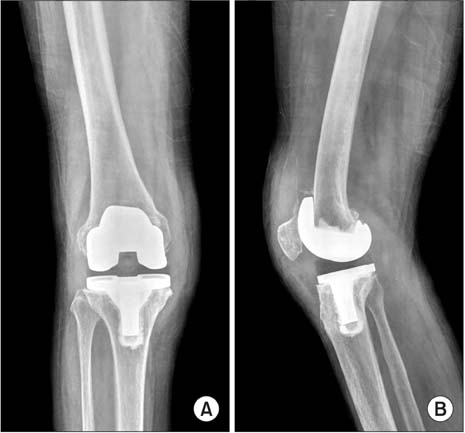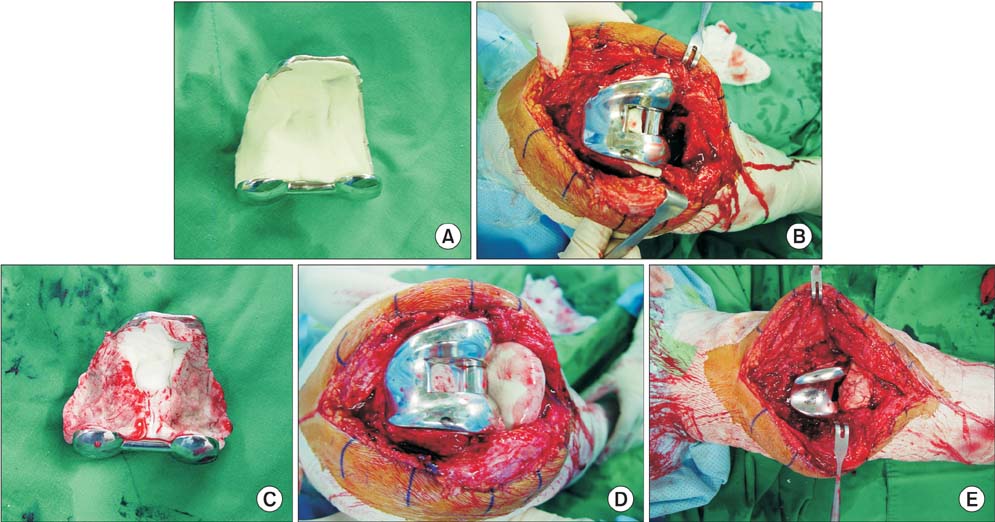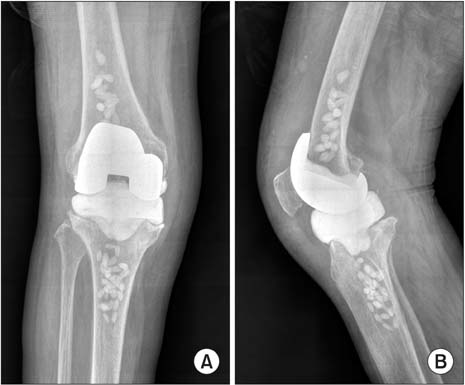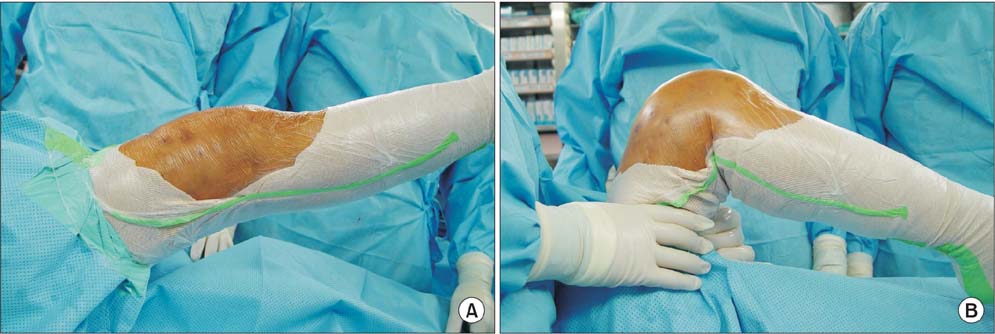Clin Orthop Surg.
2015 Sep;7(3):310-317. 10.4055/cios.2015.7.3.310.
Two-Stage Revision for Infected Total Knee Arthroplasty: Based on Autoclaving the Recycled Femoral Component and Intraoperative Molding Using Antibiotic-Impregnated Cement on the Tibial Side
- Affiliations
-
- 1Department of Orthopaedic Surgery, School of Medicine, Kyungpook National University, Daegu, Korea. hskyung@knu.ac.kr
- KMID: 2234084
- DOI: http://doi.org/10.4055/cios.2015.7.3.310
Abstract
- BACKGROUND
The purpose of this study was to determine the degree of infection control and postoperative function for new articulating metal-on-cement spacer.
METHODS
A retrospective study of 19 patients (20 cases), who underwent a two-stage revision arthroplasty using mobile cement prosthesis, were followed for a minimum of 2 years. This series consisted of 16 women and 3 men, having an overall mean age of 71 years. During the first stage of revision, the femoral implant and all the adherent cement was removed, after which it was autoclaved before replacement. The tibial component was removed and a doughy state, antibiotic-impregnated cement was inserted on the tibial side. To achieve joint congruency, intraoperative molding was performed by flexing and extending the knee joint. Each patient was evaluated clinically and radiologically. The clinical assessments included range of motion, and the patients were scored as per the Hospital for Special Surgery (HSS) and Knee Society (KS) criteria.
RESULTS
The mean range of knee joint motion was 70degrees prior to the first stage operation and 72degrees prior to the second stage revision arthroplasty; following revision arthroplasty, it was 113degrees at the final follow-up. The mean HSS score and KS knee and function scores were 86, 82, and 54, respectively, at the final follow-up. The success rate in terms of infection eradication was 95% (19/20 knees). No patient experienced soft tissue contracture requiring a quadriceps snip.
CONCLUSIONS
This novel technique provides excellent radiological and clinical outcomes. It offers a high surface area of antibiotic-impregnated cement, a good range of motion between first and second stage revision surgery for the treatment of chronic infection after total knee arthroplasty, and is of a reasonable cost.
Keyword
MeSH Terms
-
Aged
Anti-Bacterial Agents/*administration & dosage/*therapeutic use
Arthroplasty, Replacement, Knee/*adverse effects/*instrumentation/methods
Bone Cements/*therapeutic use
Female
Humans
Male
Middle Aged
Prosthesis-Related Infections/*surgery
Range of Motion, Articular/physiology
Reoperation/*instrumentation/methods
Retrospective Studies
Treatment Outcome
Anti-Bacterial Agents
Bone Cements
Figure
Cited by 2 articles
-
Safety of Temporary Use of Recycled Autoclaved Femoral Components in Infected Total Knee Arthroplasty: Confirming Sterility Using a Sonication Method
Hyung-Jin Park, Hee-June Kim, Shukho Kim, Seong-Min Kim, Jong-Uk Mun, Jungmin Kim, Hee-Soo Kyung
Clin Orthop Surg. 2018;10(4):427-432. doi: 10.4055/cios.2018.10.4.427.Treatment of Spinal Infection Following Bilateral Total Knee Replacement Postoperative Infection
Bum-Jin Shim, Oog-Jin Sohn, Chang-Woo Cho
J Korean Orthop Assoc. 2017;52(1):92-96. doi: 10.4055/jkoa.2017.52.1.92.
Reference
-
1. Clayton RA, Amin AK, Gaston MS, Brenkel IJ. Five-year results of the Sigma total knee arthroplasty. Knee. 2006; 13(5):359–364.2. Keating EM, Meding JB, Faris PM, Ritter MA. Long-term followup of nonmodular total knee replacements. Clin Orthop Relat Res. 2002; (404):34–39.3. Cui Q, Mihalko WM, Shields JS, Ries M, Saleh KJ. Antibiotic-impregnated cement spacers for the treatment of infection associated with total hip or knee arthroplasty. J Bone Joint Surg Am. 2007; 89(4):871–882.4. Fehring TK, Odum S, Calton TF, Mason JB. Articulating versus static spacers in revision total knee arthroplasty for sepsis: the Ranawat Award. Clin Orthop Relat Res. 2000; (380):9–16.5. Bengtson S, Knutson K. The infected knee arthroplasty: a 6-year follow-up of 357 cases. Acta Orthop Scand. 1991; 62(4):301–311.6. Leone JM, Hanssen AD. Management of infection at the site of a total knee arthroplasty. J Bone Joint Surg Am. 2005; 87(10):2335–2348.7. Hsu YC, Cheng HC, Ng TP, Chiu KY. Antibiotic-loaded cement articulating spacer for 2-stage reimplantation in infected total knee arthroplasty: a simple and economic method. J Arthroplasty. 2007; 22(7):1060–1066.8. Emerson RH Jr, Muncie M, Tarbox TR, Higgins LL. Comparison of a static with a mobile spacer in total knee infection. Clin Orthop Relat Res. 2002; (404):132–138.9. Garvin KL, Cordero GX. Infected total knee arthroplasty: diagnosis and treatment. Instr Course Lect. 2008; 57:305–315.10. Freeman MG, Fehring TK, Odum SM, Fehring K, Griffin WL, Mason JB. Functional advantage of articulating versus static spacers in 2-stage revision for total knee arthroplasty infection. J Arthroplasty. 2007; 22(8):1116–1121.11. Huang HT, Su JY, Chen SK. The results of articulating spacer technique for infected total knee arthroplasty. J Arthroplasty. 2006; 21(8):1163–1168.12. Hwang JK, Oh CW, Lee HJ, Kyung HS. An articulating versus non-articulating spacer for 2-stage reimplantation patients who undergo in infected total knee arthroplasty. J Korean Knee Soc. 2009; 21(3):150–157.13. Kim SH, Han HS, Kim DH, Kang SB. Two-stage reimplantation in infected total knee arthroplasty (a method of reinsertion of the autoclaved femoral component and a polyethylene liner). J Korean Knee Soc. 2010; 22(2):110–116.14. Lombardi AV Jr, Berend KR, Adams JB, Karnes JM. Articulating antibiotic spacers: the standard of care for an infected total knee arthroplasty. Orthopedics. 2007; 30(9):782786–787.15. Park KH, Cheon SH, Lee JH, Kyung HS. Incidence of venous thromboembolism using 64 channel multidetector row computed tomography-indirect venography and anticoagulation therapy after total knee arthroplasty in Korea. Knee Surg Relat Res. 2012; 24(1):19–24.16. Durbhakula SM, Czajka J, Fuchs MD, Uhl RL. Antibiotic-loaded articulating cement spacer in the 2-stage exchange of infected total knee arthroplasty. J Arthroplasty. 2004; 19(6):768–774.17. Hofmann AA, Goldberg T, Tanner AM, Kurtin SM. Treatment of infected total knee arthroplasty using an articulating spacer: 2- to 12-year experience. Clin Orthop Relat Res. 2005; (430):125–131.18. Romano CL, Gala L, Logoluso N, Romano D, Drago L. Two-stage revision of septic knee prosthesis with articulating knee spacers yields better infection eradication rate than one-stage or two-stage revision with static spacers. Knee Surg Sports Traumatol Arthrosc. 2012; 20(12):2445–2453.19. Hofmann AA, Kane KR, Tkach TK, Plaster RL, Camargo MP. Treatment of infected total knee arthroplasty using an articulating spacer. Clin Orthop Relat Res. 1995; (321):45–54.20. Jamsen E, Sheng P, Halonen P, et al. Spacer prostheses in two-stage revision of infected knee arthroplasty. Int Orthop. 2006; 30(4):257–261.21. Pietsch M, Hofmann S, Wenisch C. Treatment of deep infection of total knee arthroplasty using a two-stage procedure. Oper Orthop Traumatol. 2006; 18(1):66–87.22. Kalore NV, Maheshwari A, Sharma A, Cheng E, Gioe TJ. Is there a preferred articulating spacer technique for infected knee arthroplasty? A preliminary study. Clin Orthop Relat Res. 2012; 470(1):228–235.23. Gooding CR, Masri BA, Duncan CP, Greidanus NV, Garbuz DS. Durable infection control and function with the PROSTALAC spacer in two-stage revision for infected knee arthroplasty. Clin Orthop Relat Res. 2011; 469(4):985–993.24. Ha CW. A technique for intraoperative construction of antibiotic spacers. Clin Orthop Relat Res. 2006; 445:204–209.25. Van Thiel GS, Berend KR, Klein GR, Gordon AC, Lombardi AV, Della Valle CJ. Intraoperative molds to create an articulating spacer for the infected knee arthroplasty. Clin Orthop Relat Res. 2011; 469(4):994–1001.
Article26. Costa L, Luda MP, Trossarelli L, Brach del Prever EM, Crova M, Gallinaro P. In vivo UHMWPE biodegradation of retrieved prosthesis. Biomaterials. 1998; 19(15):1371–1385.
Article27. Premnath V, Harris WH, Jasty M, Merrill EW. Gamma sterilization of UHMWPE articular implants: an analysis of the oxidation problem: ultra high molecular weight poly ethylene. Biomaterials. 1996; 17(18):1741–1753.
Article28. Ihn JC, Park CY, Kyung HS, Kim JH. Experimental study of release of the gentamicin from PMMA beads: in vivo study. J Korean Orthop Assoc. 1997; 32(7):1750–1755.
Article29. Malekzadeh D, Osmon DR, Lahr BD, Hanssen AD, Berbari EF. Prior use of antimicrobial therapy is a risk factor for culture-negative prosthetic joint infection. Clin Orthop Relat Res. 2010; 468(8):2039–2045.
Article30. Springer BD, Scuderi GR. Evaluation and management of the infected total knee arthroplasty. Instr Course Lect. 2013; 62:349–361.
- Full Text Links
- Actions
-
Cited
- CITED
-
- Close
- Share
- Similar articles
-
- Two-Stage Revision Using a Modified Articulating Spacer in Infected Total Knee Arthroplasty
- The Modified Static Spacers Using Antibiotic-Impregnated Cement Rod in Two-Stage Revision for Infected Total Knee Arthroplasty
- Role of Articulating Spacer in Two Stage Reimplantation of Infected Total Knee Arthroplasty
- Two-stage revision of infected total knee arthroplasty
- Two - Stage Revision of Infected Total Knee Arthroplasty using Antibiotics: Impregnated Cement Spacer






